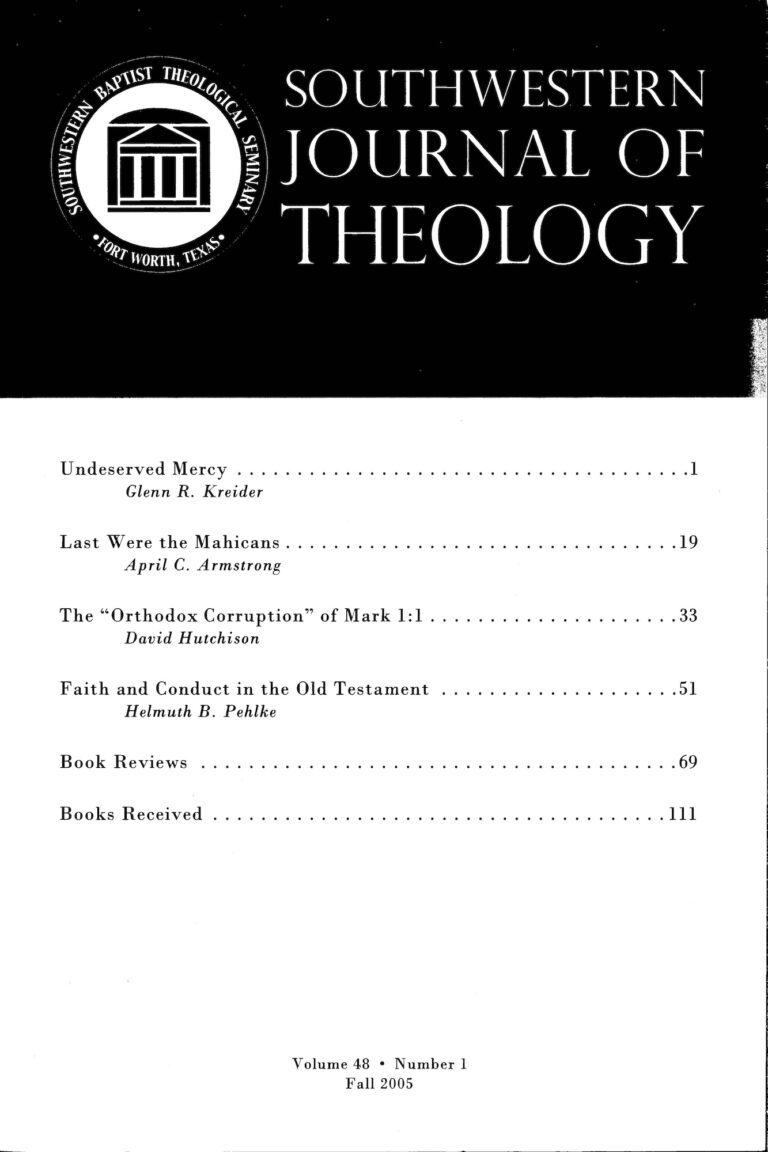
Southwestern Journal of Theology (48.1)
Southwestern Journal of Theology
Volume 48, No. 1 - Fall 2005
Editor: Paige Patterson
Picturing Christian Witness. By Stanley Skreslet. Grand Rapids: Eerdmans, 2006. 261 pages. Softcover, $24.99.
In Picturing Christian Witness, Stanley Skreslet seeks to renew a New Testament theology of Christian mission through the use of visual images. To accomplish this, his work examines the mission practice of Jesus’ followers in the New Testament and illustrates these practices with appropriate visual images. The five images he selects are announcing good news, sharing Christ with friends, crossing social barriers, shepherding sheep, and cooperating in planting and building. He includes thirty-one figures to illustrate his work (xiii-xv).
Skreslet has selected personal images of mission over corporate images because he perceives an imbalance in previous studies in favor of the corporate images. Additionally, the choice of personal images offers several advantages that may aid followers of Christ in their attempts to share their faith. By focusing on personal and individual images, he can depict ordinary Christians, growing Christians, and imperfect Christians, each of whom seek to fulfill Christ’s mission. Almost all Christians involved in mission perceive themselves in one of these three categories, and Skreslet anticipates helping them.
Skreslet aims to offer a theology of mission capable of moving Christians into the twenty-first century. He believes that new, fresh images may help him accomplish this worthy goal. To achieve this end, he attempts to apply the New Testament more directly to the visual depiction of Christian mission. He argues that past images of Christian mission depicted so-called Western superiority (227). For this reason, the Christian world, especially in ecumenical circles, needs new images that set aside the images of the past in favor of images that will chart a course for the future. His study of the New Testament leads him to conclude that no single image dominated the New Testament, but that early Christians used a variety of images to depict mission. Consequently, interpreters should not ascribe this diversity to postmodernism. In the end, Skreslet defines Christian mission as action, and specifically, the actions of “announcing Good News, sharing Christ with friends, interpreting, shepherding, and planting/building” (236).
Several items commend Skreslet’s work. To begin with, the figures Skreslet includes in his work accomplish his purpose. The reviewer is unremarkably ordinary in his appreciation for art, and Skreslet’s figures instructed his uninitiated mind and uninitiated heart (see especially figures 6, 9, 16, 17, 18, 21). Readers/viewers who are as uninitiated with art as the reviewer will appreciate Skreslet’s interpretation of the figures he uses. His use of figures to advance mission theology and practice reminds readers/viewers of the power of images in the teaching of mission. The reviewer will consider expanding his use of images in the classroom.
Readers will find some trouble with Skreslet’s naivete and assumptions. He assumes that images from previous eras, even some biblical images, communicate values at odds with the gospel (19). Among these, he numbers warfare images. While most Christians would consider images of the crusades as out of bounds for Christian use, the warfare image is entirely appropriate. Christ has little problem with it for He has promised to return on a white stallion to defeat evil. Warfare unbib-lically conceived always deserves Christian condemnation, but warfare conceived of biblically deserves support from both the theological and artistic communities. If Skreslet dismisses images that offend non-Christians, he will eventually find himself dismissing his own images, for each of his images visualize the insufficiency of non-Christians religions. His images also visualize the need non-Christians have for the church to proclaim the good news, their need for Christian friends to share Christ with them, their need of shepherding into the fold, their need to become a part of Christ’s new building, and their need for the Lord to harvest them in his new crop of eternal life. There is no end to the concessions the world will demand of Christian images once Christians back away from legitimate biblical images.
Despite this, Skreslet has offered a unique work that should enhance the reflection upon and practice of Christian mission. If readers/viewers take his work seriously, and if they can grow in their appreciation of visual arts, they will help Skreslet achieve the purpose behind his commendable work.





